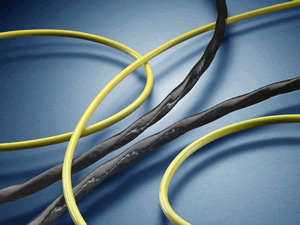Filtering in a Wire
Filterline cables may solve your EMI issues.
Robert Moore, Sr. Principal Engineer, TE Connectivity
More years ago than I care to admit, a maker of game consoles came to us with a challenging problem. The cable from the console to the television was acting like an antenna and interfering with the console’s operation. One solution we proposed: a filterline cable.
Filterline Cables
A filterline cable contains an absorptive layer of ferrite-loaded polymer. This layer provides high-frequency EMI absorptive characteristics, with a passband up to 100MHz and full filtering up through 12GHz. To achieve maximum attenuation, the electromagnetic fields must be concentrated in the absorptive layer — a requirement the cable’s shield effectively satisfies.
The cable eliminated the problem, but it was too expensive for the competitive consumer game market at the time. Left with a great solution, we began looking for a suitable problem.
 Fast-forward a few years to a problem faced by the United States Navy. Ship radar and other systems were interfering with naval helicopters’ controls. After evaluating the issue, we recommended filterline cable, which is suitably ruggedized for military needs. The Navy tried it, and the problem disappeared.
Fast-forward a few years to a problem faced by the United States Navy. Ship radar and other systems were interfering with naval helicopters’ controls. After evaluating the issue, we recommended filterline cable, which is suitably ruggedized for military needs. The Navy tried it, and the problem disappeared.
The Army faced similar problems. Rumor has it that Army brass were forbidden to fly to ships for meetings in Army helicopters. I don’t know if it’s true, but it’s a good story. The Army first tried filter connectors before finally settling on filterline cable to fix the problem. Today, filterline cables are used in a number of military and aerospace applications.
On to off-road racing, and the Baja 500 in particular. Commercial 900MHz wireless signals were interfering with the car’s electronics. Here again, filterline cables solved the problem.
Although filterline cables were too expensive for consumer gaming applications, they delivered effective solutions ideal for military, aerospace, and autosport applications. These industries have larger budgets and aren’t driven by competition like the consumer market. That is not to say that cost is unimportant, but functionality comes first in high-intensity markets like these.
EMI issues in commercial aircraft — a market in which cost moves up a few lines towards the top — are increasing for two reasons. First is the rapid growth of onboard electronics, both for flight controls and for passenger networks. Second is the increased use of composites throughout the plane to save weight. A “pure” composite is electrically transparent and provides no protection from EMI. There are several methods of adding shielding, such as surface coatings or adding conductive materials embedded in the composite, but we are seeing selective use of filterline cables in commercial aircraft to combat EMI.
One of the attractions of filterline cables is their simplicity in application. They can be terminated with standard procedures and crimp connects. Filter connectors, on the other hand, are typically equipped with solder cup terminations. The cable diameter is increased only slightly. FIlterline cables are generally available with conductors spanning 24 to 16AWG and a range of military grade jackets, insulation, shielding, and conductor materials. Additionally, since insertion loss is proportional to length, filtering characteristics can be adjusted by using longer or shorter cables.
While not an everyday product for mainstream use, filterline cables are niche products that are well suited to solving specific EMI issues. And the nice thing is that, as technology advances, the number of niches continues to grow.
 Robert Moore is a Principal Engineer – Development for TE Connectivity’s Aerospace, Defense & Marine business unit. He has more than 30 years’ experience designing, developing, specifying, and evaluating RF and data communication products for aerospace, marine, and ground systems.
Robert Moore is a Principal Engineer – Development for TE Connectivity’s Aerospace, Defense & Marine business unit. He has more than 30 years’ experience designing, developing, specifying, and evaluating RF and data communication products for aerospace, marine, and ground systems.
Recently posted:
[related_posts limit=”10″]






